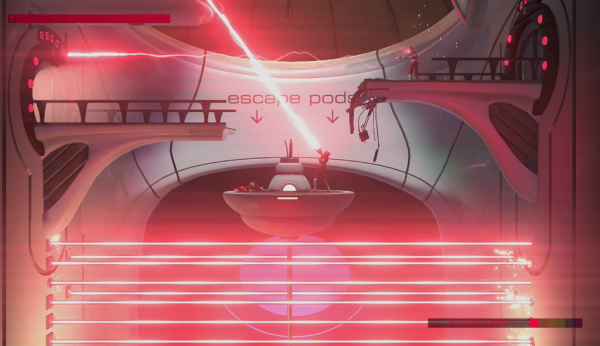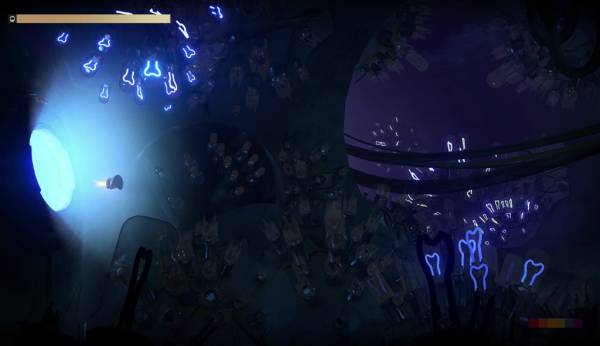Also On: PC
Publisher: Adult Swim Games
Developer: Double Fine Productions
Medium: Digital
Players: 1
Online: No
ESRB: T
My self proclaimed Metroidvania month is coming to an end with the release of Headlander. After Song of the Deep ended up rather; ?meh?, I was eager to see what Double Fine Productions had in store for everyone. Double Fine has so many great cult classic titles under their belt and I think that Headlander is another notch on that belt. You might know from some of my other reviews, I?m a sucker for games that take place in different eras. Headlander is a perfect emulation of what we thought a sci-fi future would be like during the 70?s (well what people who lived during the 70?s thought it might be like? I?m not that old). This may work as a positive or a negative depending on how you feel about that time period and genre. It?s also got some of that quirky humor we?ve grown accustom to from Double Fine as well. If a quirky retro sci-fi game doesn’t pique your interest, you might not want to skip the rest of this review.
The retro sci-fi look and feel of Headlander was a huge selling point for me, but I should also say the gameplay is no slouch as well. You start the game as a head without a body. Your head is in a helmet that has thrusts to help it maneuver through the air. Along the way you unlock new abilities for your head to utilize, the first of which is a vacuum ability. What would you need a vacuum sucking ability for? Why, sucking off robot heads, of course! How else could you land your head? (See what I did there? hahaha.) Sucking off heads, then utilizing the headless bodies by landing on them is essentially all you will do throughout the game and I didn?t get tired of it one bit. Sure there is some solo head flying areas, but getting new bodies and figuring out puzzles will mostly involve going from body to body. The bodies also don?t have to resemble humans, without spoiling anything. Many of the bodies, mostly the non-weaponized robots, feature some different 70?s style dance moves, and also can interact with other robots.
The enemy robots are color coded, which match doors throughout the huge map of Headlander. So for example, in order to get through the yellow door, you?ll need the body of a yellow enemy. There?s a hierarchy for opening earlier doors, with higher level colors also, so the process of finding matching bodies for doors doesn?t get too tedious. Many of the puzzles are decided through the process of getting new bodies, rather than upgrades unlocked as you progress. Don?t get me wrong, there definitely are parts that require purchased upgrades, but upgrading and obtaining new abilities isn?t as prevalent as in something like Metroid. The way you find upgrades and lack of required abilities reminds me a lot of Shadow Complex (which I coincidentally reviewed the remastered version of early this year, here). Many of the upgrades are just one of a set grouping and you can complete the game without finding any of them if you choose.
Going in kind of blind, with the exception of watching a few minutes of e3 gameplay, everything in Headlander was a surprise to me. Like most Metroidvania games, I thought there would be a bunch of different abilities and weapons, which is not the case, it?s almost the opposite. You might think I would consider that a negative, but it actually ended up being one of my favorite things about the game. Headlander is innovative, original and compelling from beginning to end. Unlike Song of the Deep, I never felt like I was getting a lesser experience due to lack of weapons and abilities. You?re a head after all, so there’s only so many features you could add onto your dome. I won?t spoil what they are, but let me talk a little about the weapons. So in order to use anything besides your head as a weapon, you need to commandeer an enemy body (or turret). Each enemy has varying style of weapon, and just like there is a hierarchy in enemy color, there is varying weapons that damage and shoot to differing degrees. Some enemies even use melee attacks rather than guns, so there definitely is enough ways to take out other enemies and conquer puzzles (wait for the chess area of the game).
I want to briefly mention how tight the controls are for Headlander. I feel this is important to not undercut because with a head flying all over the environment there was a chance that the controls could be loose, not so polished, and just seem off (::cough::Song of the Deep::cough::). The flying controls I actually found to be more precise than while you’re docked into most bodies, but I assume that is done intentionally to some degree. Robots vary in control and appearance and should be controlled appropriately.
Headlander is the retro sci-fi Metroidvania game that no one knew they needed. I really didn?t know what to expect when the game was announced, and even after watching some e3 gameplay, I thought the novelty would wear thin quickly. I couldn?t have been more wrong. While I?m a broken record about how much I loved Axiom Verge, I would put Headlander right up there with it. One drawback, in my opinion, was that the game kind of felt linear, while still being in a huge Metroidvania style map. There wasn?t too many reasons to back track to areas, other than to find hidden upgrades and abilities. Some of my favorite moments of Axiom Verge and Metroid games, is noticing areas that I can?t get to, then hours later realizing I now have what I need to get into that particular area. Headlander doesn?t feature too many of those moments. Minor gripe aside, I expect Headlander to reach that cult classic status like many of Double Fine?s prior titles and it?s well deserved. This is a must own for fans of the genre.




